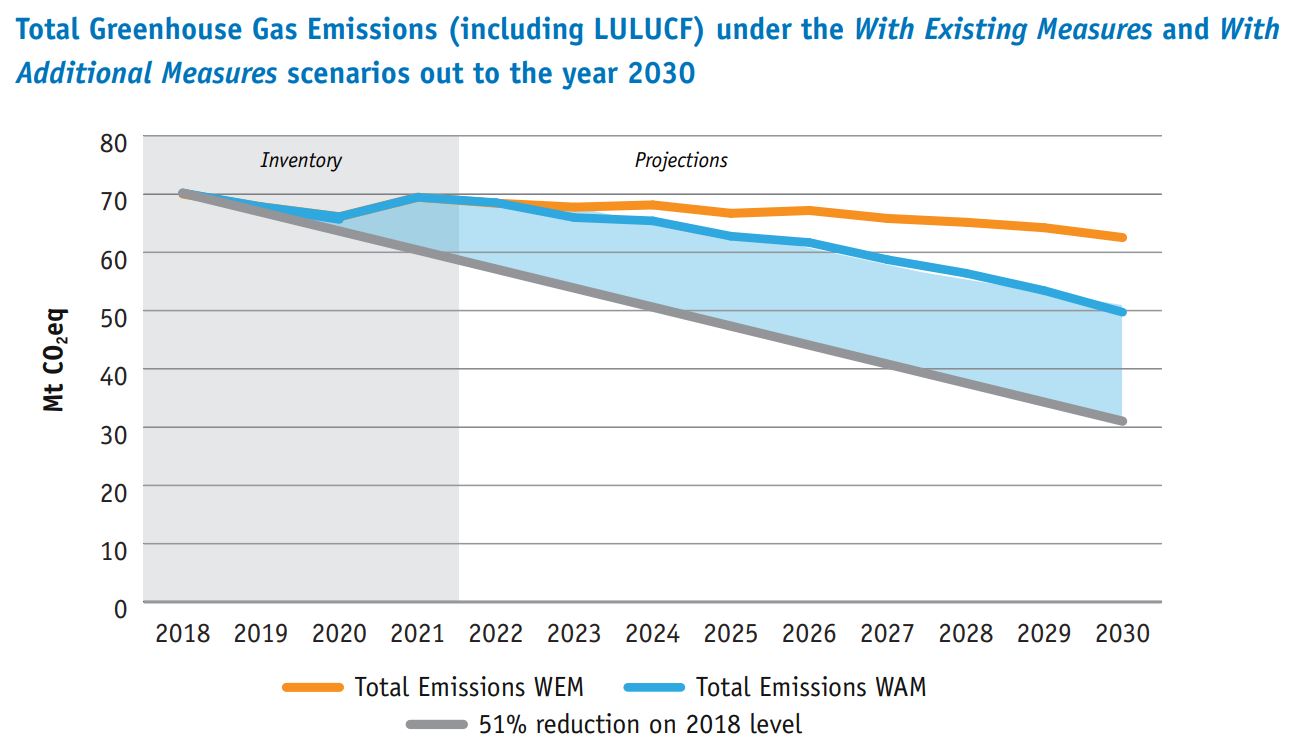The latest projections (June 2023) indicate that that currently implemented measures (With Existing Measures) will achieve a reduction of 10% on 2005 levels by 2030, significantly short of the 42% reduction target. If measures in the higher ambition (With Additional Measures) scenario are implemented, EPA projections show that Ireland can achieve a reduction of 30% by 2030, also still short of the 42% reduction target.
Ireland’s 2030 target under the EU’s Effort Sharing Regulation (ESR) was to deliver a 30% reduction of emissions compared to 2005 levels by 2030. The ESR was amended in April 2023 and Ireland must now limit its greenhouse gas emissions by at least 42% by 2030. The new 42% reduction target now applies for 2030, but new annual emission limits that are binding under the ESR have yet to be fully implemented. The assessment made therefore focusses on the pre-existing ESR Annual Emission Allocations that were associated with the earlier ESR 30% reduction target.
The ESR provides two flexibilities (EU-ETS and LULUCF) to allow for a fair and cost-efficient achievement of the targets. The full LULUCF flexibility of 26.8 Mt CO2 eq (theoretically available to Ireland under the ESR) is not considered to be possible to achieve based on the latest Projections. New research led to a revision to the emission factor associated with forestry on organic (peat) soils and when this was implemented in the 2022 EPA Projections report, it led to decreased projected removals/increased emissions associated with forest land for all periods. The total amount of LULUCF flexibility now projected to be available is 9.3 Mt CO2 eq, significantly less than the theoretical flexibility available. The projections show that Ireland can achieve compliance under the ESR in the With Additional Measures scenario using the EU-ETS and LULUCF flexibilities but only with implementation of the Climate Action Plan 2023. Using both flexibilities gives a cumulative surplus under the ESR of just 2.2 Mt CO2 eq,. This is a small amount of headroom and highlights the need for full and rapid implementation of policies and measures in the Climate Action Plan 2023.
Use of the EU-ETS flexibility alone is not projected to achieve compliance under the ESR (cumulative exceedance of 7.1 Mt CO2 eq) even with full implementation of policies and measures in the Climate Action Plan 2023.
Projected Non EU-ETS emissions and estimated Annual Emission Allocations (AEAs) with and without use of flexibilities under the Effort Sharing Regulation (ESR) for the period 2021-2030.
The ESR targets are defined under the IPCC's 5th Assessment Report (AR5) Global warming potentials (GWP), therefore, the graph below shows the latest Projected WEM and WAM Non ETS emissions using AR5 GWPs. Projections indicate that Ireland can achieve overall ESR compliance over the period 2021 to 2030 assuming full implementation of the Climate Action Plan 2023 and the use of the flexibilities available. In terms of the 2030 targets, the ESR provides two flexibilities (use of ETS allowances and credit from action undertaken in the Land Use, Land Use Change and Forestry (LULUCF) sector) to allow for a fair and cost-efficient achievement of the targets.
In order to achieve Ireland's commitment to realising a climate neutral economy by 2050 the Climate Action and Low Carbon Development (Amendment) Act 2021 provides for the establishment of carbon budgets as interim milestones on this trajectory. The 51% target is the primary constraint on carbon budgets over the course of the first two budget periods ending on 31 December 2030, relative to 2018 emissions.
Ireland’s Climate Act ambition of a 51% emissions reduction by 2030, including LULUCF (compared to 2018) is not projected to be achieved. ‘Existing’ policies and measures can deliver an 11% reduction in Greenhouse Gas (GHG) emissions by 2030 compared to the 2018 level, with ‘Additional’ policies and measures, including from the 2023 Climate Action Plan, projected to deliver up to 29% emissions reduction over the same period.
The gap between the ‘Existing Measures’ and higher ambition scenarios in these projections highlights that the current pace of implementation will not achieve the change required to meet the Climate Act targets. Faster implementation of ‘Additional Measures’ is needed to close this gap.
